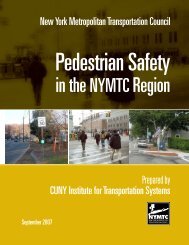Chapter 3 The Transportation System - New York Metropolitan ...
Chapter 3 The Transportation System - New York Metropolitan ...
Chapter 3 The Transportation System - New York Metropolitan ...
- No tags were found...
Create successful ePaper yourself
Turn your PDF publications into a flip-book with our unique Google optimized e-Paper software.
<strong>Chapter</strong> 32. Passenger Rail<strong>The</strong> <strong>New</strong> <strong>York</strong> City metropolitan areais unique among North American citiesdue to the sheer volume and proportionof passenger traffic carried by rail inthe region. Including the <strong>Metropolitan</strong><strong>Transportation</strong> Authority (MTA) <strong>New</strong><strong>York</strong> City Transit, MTA Long IslandRail Road (LIRR), MTA Metro-NorthRailroad, and MTA Staten Island Railway,there are over 9 million unlinkedpassenger trips made daily, amounting to30 percent of all commuter trips madein the <strong>New</strong> <strong>York</strong> City metropolitan area.Other major cities in the United States– even those with substantial passengerrail networks, such as Washington D.C.,Boston, Chicago and Philadelphia, donot come close to this number or proportionof trips. 1This section reviews three categories ofpassenger rail: rapid transit (subways),commuter rail, and long-distance rail(Amtrak). While the <strong>New</strong> <strong>York</strong> City subwayis the dominant rapid transit systemin the region, tens of millions of passengersannually are also carried by PortAuthority Trans-Hudson (PATH) trains.Three major commuter rail systems alsoserve the region. Two of them, the LIRRand Metro-North Railroad, are operatedby the MTA, while <strong>New</strong> Jersey Transitoperates commuter rail services between<strong>New</strong> <strong>York</strong>’s Penn Station and much ofnorthern <strong>New</strong> Jersey. Finally, Amtrak,the nation’s long-distance passenger railcarrier, also serves the NYMTC regionand surrounding areas. All of these servicesare described in the section below.RAPID TRANSITRapid transit is a transit system that cancarry large numbers of people with greatfrequency. It can include a passenger railsystem and bus rapid transit (which isdescribed in section 3 of this chapter).<strong>The</strong> passenger rail system can be undergroundor elevated and is grade separatedfrom other traffic. In the NYMTC planningarea, the <strong>New</strong> <strong>York</strong> City Subway isone of the world’s premier rapid transitsystems; PATH trains serve as the primarytransit link between Manhattan andthe neighboring <strong>New</strong> Jersey urban communitiesand suburban commuter railroads.Ridership on both is expected tocontinue to increase with the anticipatedgrowth in regional residential, commercial,and business development.MTA <strong>New</strong> <strong>York</strong> City Subway<strong>The</strong> MTA <strong>New</strong> <strong>York</strong> City subway systemoperates 24 routes, spanning 660 miles oftrack and 420 stations. 2 In 2011, annualsubway ridership was 1.640 billion – itshighest level since 1950. <strong>The</strong> most significantreason for this growth is the onethirdincrease in average weekday ridershipbetween 1998 and 2011. However,weekend subway usage has also increased,both in absolute numbers and relative toweekday travel. See Table 3.1. 3A new railcar fleet and four new freetransfer connections were two of the mostvisible signs of capital expenditures. <strong>The</strong>Table 3.1new transfers – at South Ferry-WhitehallStreet (R, 1), Jay Street-MetroTech (A,C, F, R), Court Square (E, G, M, 7), andBroadway-Lafayette-Bleecker Street (B,D, F, M, 6) – provided passengers withnew travel options. (<strong>The</strong> Bleecker Streettransfer complements an existing transferbetween the downtown Bleecker Street(6) platform and the Broadway-Lafayettestation.) <strong>The</strong> new South Ferry (1) station,which included an entirely new10-car platform, was financed largelywith federal post-9/11 recovery money.Finally, the Fulton Street Transit Center,scheduled for completion in 2014, willprovide enclosed free transfers betweenthe existing Fulton Street station (A,C, J, Z, 2, 3, 4, 5) in lower Manhattan,the Cortlandt Street (R) station and theWorld Trade Center (E) station.<strong>The</strong> delivery of the new R160 subway carfleet between 2005 and 2010 replacedrolling stock which had been runningsince the 1960s and 1970s. <strong>The</strong> R160cars are running on the lettered (formerBMT and IND) routes.Proportional Increases in Weekend NYC Subway Ridership, 1998‐2012Year Weekday Saturday SundaySaturday %of WeekdaySunday % ofWeekday1998 3,962,222 2,015,003 1,490,327 50.86 37.611999 4,226,709 2,206,869 1,625,211 52.21 38.452000 4,522,410 2,393,186 1,794,874 52.92 39.692001 4,579,222 2,512,490 1,883,489 54.87 41.132002 4,590,570 2,573,817 1,937,375 56.07 42.22003 4,511,857 2,469,237 1,884,342 54.73 41.762004 4,612,703 2,594,065 1,973,605 56.24 42.792005 4,737,093 2,660,594 2,058,666 56.17 43.462006 4,865,769 2,735,177 2,090,005 56.21 42.952007 5,042,150 2,917,234 2,211,490 57.86 43.862008 5,229,435 2,981,699 2,312,745 57.02 44.232009 5,086,822 2,928,247 2,283,621 57.57 44.892010 5,156,913 3,031,289 2,335,077 58.78 45.282011 5,284,295 3,033,660 2,367,261 57.41 44.82012 5,380,184 3,172,627 2,490,736 58.96 46.923-6 Plan 2040: NYMTC Regional <strong>Transportation</strong> Plan
















